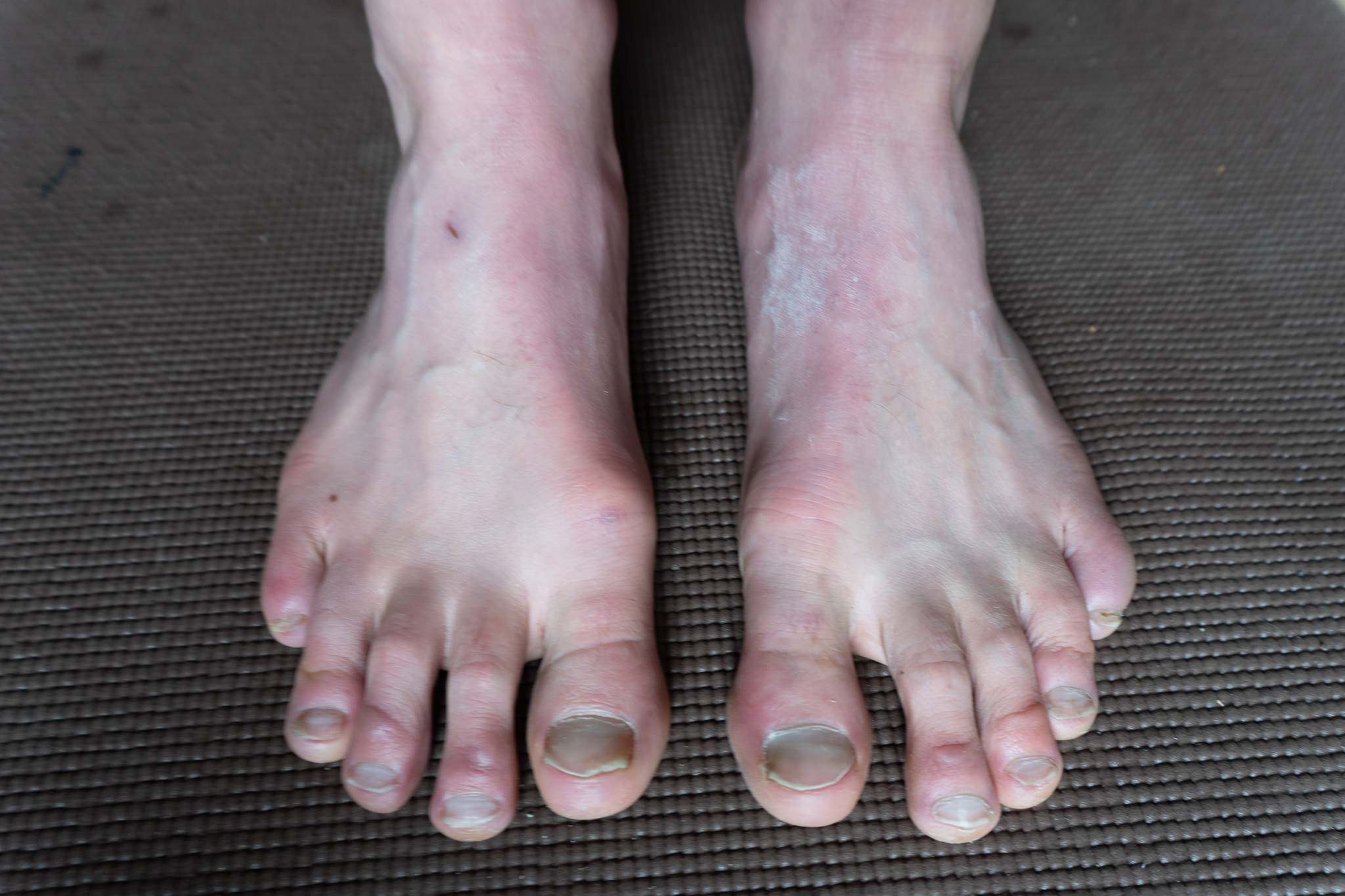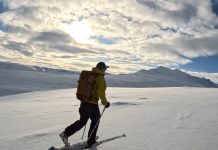As cyclists, a good bike position for comfort and performance is essential, adapting it to our riding preferences, whether we’re racing short events, multi day, long distance or ultra bikepacking events. Focus is on the contact points of hand position, the saddle area and the pedal to shoe interface, but shoe fit is often omitted. Custom moulded insoles can be made, but a proper fitting shoe seems to come secondary to choosing a pair based on features. Being outside of what is considered to be a standard width and foot shape complicates shoe choice, making finding appropriate shoes a challenge, especially if you are at the wider end of the spectrum. Here, I delve into some of the issues of foot shape and width and how to look after our feet off the bike.
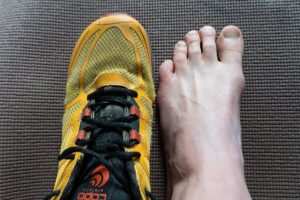
This a subject close to home as I have exceptionally wide feet. My measurements are 112mm at their widest point with 273mm and 270mm lengths for the left and right feet respectively . My first 4 toes are almost level save for the 2nd toe which is the longest, tapering down to the little toe. A square forefoot with a wide midfoot, normalising at the hind foot.
It’s been a challenge over the years to find suitable cycling shoes, even having to size up in some brands’ wide offerings. I was increasingly struggling with foot issues as I tackled longer distances, where for shorter distances I just put up with the discomfort, blissfully happy at removing the shoes post ride. We very quickly become aware if there is hand, saddle or lower back discomfort but there seems to be a disconnect with the feet. Feet seem to be able to accommodate shoes which don’t quite fit properly, squashing toes together and closing down on the midfoot, so long as the heel is held fast. The traditional esthetiques of shoe shape being in part culpable. Few manufacturers have ventured away from this to a more appropriately shaped forefoot design, similarly for running shoes. This traditional shape does of course fit some riders’ feet and many will happily fit into a standard fit shoe. I have tried numerous brands: Lake, Bontrager, Shimano, Cube, Specialized and Fizik with varying ability to ride distance in them.
It wasn’t until I started to wear shoes for everyday, cycling and running wear which properly accommodated my foot width and shape that I realised the extent to which I had been putting up with ill fitting shoes for many years. In the post race chats at the Atlas Mountain Race, a 1142km bikepacking route through Morocco, it was interesting to hear just how many riders do suffer from foot issues.
With my everyday shoes having been minimalist barefoot foot style for the past 6 years, my feet have spread to their natural width and shape, but not without some lingering signs of having worn narrow shoes for years. Other shoes which used to fit reasonably comfortably are now the opposite. Putting my feet side by side with cycling shoes I used to wear, it’s clearly visible why.
With 26 bones, 33 articulations, 112 ligaments, 13 extrinsic and 21 intrinsic muscles [1], the foot is a complex, multifunctional unit, which can influence what happens further up the biomechanical chain and vice versa with weak or under performing muscles around the pelvis influencing what happens in the lower limb. Poor fitting shoes may contribute to poor foot mechanics, which can necessitate the use of insoles, wedges etc. Some anatomical variances and injuries do require support at the foot, but that’s a whole other issue. The foot is very capable of supporting itself and supportive shoes can contribute to a weakening of the extrinsic and intrinsic muscles removing the need for them to engage so readily. Barefoot or minimalist shoes as an everyday shoe are something to think about, as they can help to strengthen the foot complex, resulting in improved foot dynamics for sporting activity [2]. If you spend all day in a shoe which has a heel (shoe drop) then your achilles and calves are in a constant state of being short, which they will adapt to. Wearing a zero drop, minimalist shoe allows your foot to move and function normally and maintain a natural achilles/calf length. This does, of course, take time for adaptation.
Making a judgement on the best fit handlebars or saddle is made simple with size dimensions listed alongside the product, but with shoes we are presented with limited dimension information beyond the actual size. Even then some brands come up small or large for a given size and even though wide fit options are available in some brands’ top tier models, it depends on their interpretation of wide as to their actual fit. The wider your feet, the more limited the options. The exceptions are Lake and Bont, both giving measurement charts from which to make a more informed and accurate choice about the right shoe size coupled with a more foot friendly, forefoot shape.
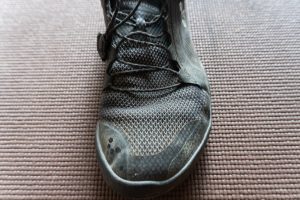
Delving into their respective sizing charts, length wise, I would be a 44 in Bont and a 43.5 in Lake. Width wise Bont’s lists >107mm however in their wide fit option. My 112mm width isn’t accommodated until their size 46, but with Bont’s being fully mouldable, perhaps the 44 could be made to fit? Lake offers 3 different lasts, Comfort, Competition and Race, all with different width measurements. Do read their sizing chart carefully though as the ‘extra wide’ Race last isn’t as wide as the ‘wide’ of the Competition last. The Competition last suits those with the widest feet, with a personally accommodating width of 113mm for their 43.5 size. Bingo! Lake offers a heat modulable heel piece on their higher end models too and numerous models for each last type, allowing for various budgets. Their MX237 endurance wide, for example, is a reasonably priced, full width option, ideal for long distance adventure riding and racing.
Whether a cyclist or runner, we need to look after our feet. Part of that is wearing the correct daily footwear and therapy as we would with the rest of the body. I’ll always begin at the feet with a lower limb treatment session. At home you can try some self massage with a solid ball, such as a golf ball or a rubberised dog chew ball for example (a tennis ball is too soft). As cyclists we tend to concentrate on quadricep and gluteal strength but how many of us are doing exercises for the calf/ankle/foot?
For some self treatment, try these:
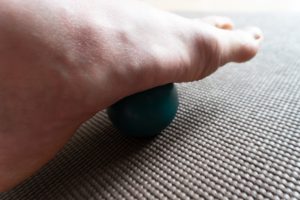
Stand on the ball starting up near the big toe and roll over the ball moving it towards the heel, putting down as much pressure as is comfortable. Harder isn’t necessarily better. Move across the foot and repeat. If there are particular sore spots, have the ball under the spot and slowly extend the toes as you apply a downward pressure on the ball. Repeat 4-5x.
For strengthening the underside structures of your foot: On a carpet or rug, in bare feet, move one foot forward by clawing your toes into the carpet. Repeat with the other foot until you have gone as far as you can. 2-3x per foot.
A simple exercise for the calves/ankle/feet are calf raises over a step. Ideal for events with sections of hike-a-bike and generally an essential one for runners. With forefoot on the step, hip width apart, warm up doing double leg raises, some with a straight leg, others with a bent knee. Idea is to be able to do these without holding on, so you are training all the stabilisers in the lower limb as well. Try this first with a double leg raise, without holding on to anything, doing as many as you can to fatigue with body weight to start, adding weight as you get stronger. Transition to single leg when able to do so or add in a few to the double leg routine. Make sure you do these near a wall or something to grab onto if you become imbalanced! 3-5 sets a couple of times a week works well.
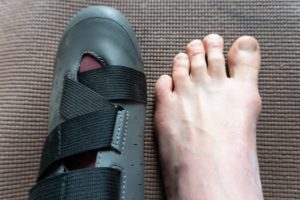
A good bikefit isn’t just about the pedal to shoe interface, but also about the actual shoe fit which isn’t just the preserve of the long distance cyclist or runner. All of us can benefit. Get a proper fitting shoe and comfort and performance can increase. Start with width and shape, then consider insoles. Think about wearing zero drop shoes as your everyday shoes (understandably not always an option depending on work conditions), with a shape that fits your forefoot (Flips flops, however, aren’t ideal as our feet are under constant tension trying to keep themselves on the flip flop). For those of us at the far end of the width scale, it can be an onerous task to find the right shoe, but it is worth the effort and the benefits are felt quickly. Lake and Bont are at least making that task easier by giving more complete shoe measurements and fitting guidelines. Lake has gone one step further, recognising that there is a demand for the really wide. Not only that, they also offer wide fit shoes across different price points as not every rider wants or needs a top tier shoe. If you are in the market for new shoes, check the fit as well the shoe’s features.
References:
- https://www.physio-pedia.com/Foot_and_Ankle_Structure_and_Function
- Sarah T. Ridge; Mark T. Olsen; Dustin A. Bruening; Kevin Jurgensmeier; David Griffin; Irene S. Davis; A. Wayne Johnson. Walking in Minimalist Shoes Is Effective for Strengthening Foot Muscles. Med Sci Sports Exerc. 2019;51(1):104-113.

